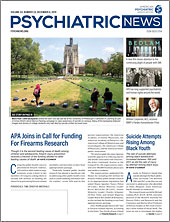Determining the appropriate medication and dosage for a patient with major depression can be a challenging and lengthy process. But a study published in Psychiatric Research & Clinical Practice adds to a growing body of literature supporting the concept that patients likely to respond to their current treatment will show evidence of improvement by the end of the second week.
“The odds of achieving remission, response, and greater than minimal improvement was higher among individuals who exhibited early improvement,” wrote lead author Paul Hicks, M.D., Ph.D., a psychiatrist at Baylor Scott & White Health and a clinical professor at Texas A&M College of Medicine, and colleagues.
“If we know when to implement decisions with regard to treatment interventions, we will potentially be able to decrease the time the patient experiences depression,” Hicks told Psychiatric News.
Hicks and his colleagues conducted a secondary analysis of data from the VA Augmentation and Switching Treatments for Improving Depression Outcomes (VAST-D) study to determine whether a patient’s early improvement can predict remission after 12 weeks. Early improvement was defined as a drop from the baseline depression severity score of 20% or more, as measured by the Quick Inventory of Depressive Symptomatology-Clinician Rated (QIDS-C), within the first two weeks of the treatment modification.
The VAST-D study involved 1,552 veterans aged 18 and older who were diagnosed with major depressive disorder and were unresponsive to at least one course of antidepressant treatment. The study participants were randomly assigned to one of three medication treatment groups: augmentation with bupropion sustained release, augmentation with aripiprazole, or switch to a different antidepressant. The dosage remained relatively constant throughout the trial, though the researchers allowed adjustments to doses as early as the end of the first week. The researchers evaluated participants at baseline and at the end of weeks 1, 2, 4, 6, 8, 10, and 12.
The researchers calculated positive and negative predictive values by evaluating whether the participants showed early improvement by the end of the second week and whether they then achieved remission by the end of week 12. The values were determined by categorizing participant outcomes based on whether patients had a true positive (they showed early improvement and achieved remission), false positive (they showed early improvement but did not achieve remission), true negative (they neither achieved early improvement nor remission), and false negative (they did not show early improvement but achieved remission).
Early improvement in patients resulted in a positive predictive value of 38.2% and a negative predictive value of 92.6%; the latter means that if the patient does not show improvement by the end of the second week on a medication, the chance of achieving remission at the end of the 12th week is less than 8%.
Hicks pointed out that the optimal change in this study was a 20% drop in the QUIDS-C score by the end of the second week, which suggests that standardized assessments of the severity of depression are necessary to help physicians determine whether an intervention change is necessary. “Our findings emphasize the importance of making measurement-based care the standard of practice,” he said.
Thirty-six participants had a false-negative outcome, meaning they entered remission after 12 weeks but did not show early improvement. Those patients were more likely to have lower baseline scores, fewer adverse childhood experiences, lower baseline Beck Anxiety Inventory Score, lower Columbia-Suicide Severity Rating Scale scores, and a higher baseline quality of life.
Compared with the participants who did not show early improvement, the false-negative patients were much less severely ill, Hicks explained. “Therefore, the false-negative patients may just be less impaired patients of the early non-improver group.”
Hicks and his colleagues noted some limitations to their study. Some of the participants’ early improvement may have been associated with the expectation of benefits associated with entering a randomized trial. The authors also pointed out that the the participants were, on average, below the target dosage for their augmenting agents or bupropion when early improvement was assessed, and 85% were male.
“People struggle with finding the right medication, but more importantly, once you and the doctor have decided this is the treatment you’re going to try, the second challenge is: Is there an early point in time when you can decide when you have made the right or wrong decision?” said Madhukar Trivedi, M.D., the Betty Jo Hay Distinguished Chair in Mental Health and Julie K. Hersh Chair for Depression Research and Clinical Care at the University of Texas Southwestern Medical Center in Dallas.
Trivedi said a big challenge in improving depression treatment is tying early improvement as a predictor of remission to biomarkers. Learning that a treatment is unlikely to help a patient is helpful, “but a better solution would be to marry some of these clinical findings with biomarkers so we can know in advance that the chance this treatment will create better outcomes is higher than the typical 30%,” he said.
The study was funded by a grant to two of the authors, Somaia Mohamed, M.D., Ph.D., and Sid Zisook, M.D., from the VA Office of Research and Development Cooperative Studies Program. ■
“Predictability of Nonremitting Depression After First 2 Weeks of Antidepressant Treatment: A VAST-D Trial Report” is posted
here.

